

4 Ways to Loop with WordPress. At the heart of the WordPress theme template is the venerable WordPress loop.

When you’re looking at your index.php file, for example, the loop is the part that typically begins with if(have_posts()) and contains all the tags and markup used to generate the page. The default loop works perfectly well for most single-loop themes, but for more advanced designs with stuff like multiple and custom loops, more looping power is needed. 10 Useful WordPress Loop Hacks. The loop is a very important aspect of WordPress blogs.
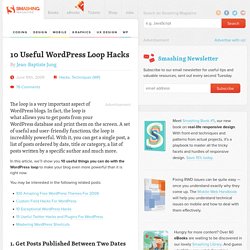
In fact, the loop is what allows you to get posts from your WordPress database and print them on the screen. A set of useful and user-friendly functions, the loop is incredibly powerful. With it, you can get a single post, a list of posts ordered by date, title or category, a list of posts written by a specific author and much more. In this article, we’ll show you 10 useful things you can do with the WordPress loop to make your blog even more powerful than it is right now. You may be interested in the following related posts: 1. Image source: Shutterstock. WordPress. Although WordPress have an effective built-in comment management interface, for several tasks like deleting bulk comments it is way easier and quicker to use SQL.

In this article, I’m going to show you some super useful SQL queries to manage your WordPress comments more easily. Despite its open source nature, WordPress sill has its limitations. There’s always 1 or 2 things you wish you could change about a specific theme, but if you’re not an experienced developer, it can be a nightmare to figure out how to make those changes. Today, I’ll showcase a great tool named Ultimatum which can help you creating complex WordPress themes with no coding. Do you want your blog or site to look really cool for the new year? 2013 has been a very exiting year for the WordPress community and tons of super handy code snippets, hacks and tips were published.
Social networks are a very important way to publicize your blog and attract new visitors. “Flat” design is the new trend in modern web design. WpRecipes.com : Daily recipes to cook with WordPress. Hacks, Snippets and Articles. 10 Tips To Optimize Your WordPress Theme. The beauty of WordPress is in how easy it is to adapt for different tasks.
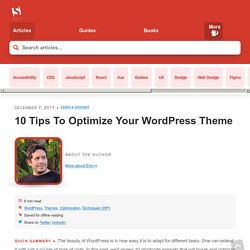
One can extend it with just a couple of lines of code. In this post, we’ll review 10 shortcode snippets that will tweak and optimize your WordPress theme. WiseStamp - Gmail Facebook Twitter...and more! Wordpress Browser detection and OS detection with body_class – 500+ Wordpress code snippets for your blog. Getting Started with WordPress Shortcodes (+Examples) WordPress shortcodes were introduced in 2.5, and help you to create macro codes to use within your content.

If you think about it, this is a great way to create something like a dynamic ad spot or a call-to-action button in your posts. If we use the call-to-action example, you could add something like this to your blogpost to show the button, and then edit the output in your templates functions.php file, which we’ll get to in a minute. To customize the button, we could simply add something like: Or to make it even better, we could use an enclosing shortcode: With some imagination, you soon realize the potential of shortcodes, and what can be done with them. Creating a self-closing shortcode The simplest shortcode is the self-closing one. All the code goes in functions.php, which is located in /wp-content/themes/your-theme/. Usage: Customize your Wordpress Dashboard.
What is WordPress Dashboard?
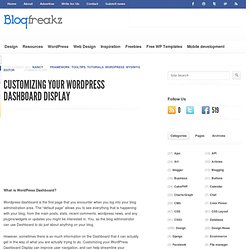
Wordpress dashboard is the first page that you encounter when you log into your blog administration area. The “default page” allows you to see everything that is happening with your blog, from the main posts, stats, recent comments, wordpress news, and any plugins/widgets or updates you might be interested in. You, as the blog administrator can use Dashboard to do just about anything on your blog.
However, sometimes there is so much information on the Dashboard that it can actually get in the way of what you are actually trying to do. Diy Theme Framework. Roles and Capabilities. Roles and Capabilities Languages: English • Español • Français • 日本語 • Português do Brasil • 中文(简体) • (Add your language) Description WordPress uses a concept of Roles, designed to give the site owner the ability to control what users can and cannot do within the site.

A site owner can manage the user access to such tasks as writing and editing posts, creating Pages, defining links, creating categories, moderating comments, managing plugins, managing themes, and managing other users, by assigning a specific role to each of the users. WordPress has six pre-defined roles: Super Admin, Administrator, Editor, Author, Contributor and Subscriber. The Super Admin role allows a user to perform all possible capabilities. Summary of Roles Super Admin – somebody with access to the site network administration features and all other features. Function Reference. Languages: English • Español • فارسی • Français • Italiano • 日本語 ქართული • 한국어 • Português do Brasil • Русский • Türkçe • עברית • 中文(简体) • 中文(繁體) • (Add your language) The files of WordPress define many useful PHP functions.

Some of the functions, known as Template Tags, are defined especially for use in WordPress Themes. There are also some functions related to actions and filters (the Plugin API), which are therefore used primarily for developing Plugins. The rest are used to create the core WordPress functionality. Function Reference/post class. Function Reference/post class Description.
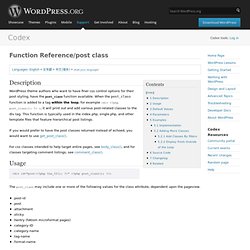
Gallery Shortcode. Gallery Shortcode Languages: English • Italiano • 日本語 • Português do Brasil • Русский • (Add your language) The Gallery feature allows you to add one or more image galleries to your posts and pages.
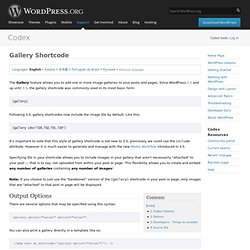
Since WordPress 2.5 and up until 3.5, the gallery shortcode was commonly used in its most basic form: [gallery] Following 3.5, gallery shortcodes now include the image IDs by default. [gallery ids="729,732,731,720"] WordPress MU Domain Mapping. This plugin allows users of a WordPress MU site or WordPress 3.0 network to map their blog/site to another domain. It requires manual installation as one file must be copied to wp-content/. When upgrading the plugin, remember to update domain_mapping.php and sunrise.php. Full instructions are on the Installation page and are quite easy to follow. You should also read this page too. Super administrators must configure the plugin in Super Admin->Domain Mapping. How To Set WordPress permalink (rewrite rules) on Nginx. These rules are already in the .htaccess on apache, but if you want to be cutting edge, and get the best performance out of your WordPress blog, you can redo them in Nginx! Why would you want to do this anyways?
Simple. In terms of serving static file requests, Nginx will take up lesser memory, use few resources and is just clearly faster. The permalink rules need to be placed in your nginx site configuration (the vhost file) under your sites name. How to add Facebook "Like" button to your WordPress Blogs. Now, it is easier than ever to add the Facebook famous “Like”/”Recommend” to your posts and increase your blog popularity. The “Like” button allows users to share their ‘like’ of your WordPress Blog with their friends on Facebook. Every time a user clicks on the “Like” button on your blog, it creates a status update on the user’s Facebook News Feed with a link back to your WordPress Blog.
PLUGINS. THEME. CHEAT SHEET. Abilitare la funzione MultiSito in WordPress 3.0. WordPress 3.0 segna l’unione di WordPress con WordPress MU, permettendo cosi’ di gestire un network di siti o blog che dir si voglia con WordPress. In questo articolo, andremo a vedere come abilitare il sottomenu Network e le funzioni di MutiSito in WordPress 3.0. Non dovrai seguire questi passaggi se stai facendo un aggiornamento da WordPress MU. Segui le istruzioni per aggiornare da WordPress MU, bensi’ questo articolo fa per te se vuoi aggiornare una versione standard di WordPress (2.9.2, scelta ottimale) alla nuova versione 3.0 di WP abilitando la funzione MultiSito.
Abilitare il menu Network Aggiungere la seguente linea al file wp-config.php: Il voce Network nel menu Strumenti (Tools) non comparira’ prima di aver seguito questo passo. Creare il Network Eseguire il login nell’area amministrativa di WordPress e cliccare sulla voce Network nel menu Tools, o Strumenti una volta che sara’ in Italiano. Sottodomini: 10 Snippets to Make WordPress User-Friendly (part 1) Just on a side post to our usual jQuery posts I have been using WordPress quite a lot, especially developing it for clients and here are some tips. Out-of-the-box, WordPress is a fairly simple CMS for anyone to learn. But for your non-tech savvy clients it could be a nightmare and a potential disaster to the site you have just built. There are of course many plugins that will achieve the same as these snippets, but with code you get the added control and security, and, in most cases, will not need to be updated.
9 Snippets to Make WordPress User-Friendly. As we’ve promised, here’s more of those awesome WordPress snippets to make your website more user friendly for your clients. Trust me when I say PHP can be fun too! Enjoy! Related posts: 20 Snippets and Hacks to Make WordPress User-Friendly for your Clients (part 1) 1. This code will get rid of the ‘Incoming Links’ widget for authors and editors and then clean up some of the other boxes for everyone.
Source. WordPress 3.2 Full Page Writing Screen. Posted on 28 July, 2011 By Kim Woodbridge. 10 Plugin Replacing Tutorials for WordPress. Let face it, the main reason why WordPress is so popular is because of the endless supply of plugins that make it highly extensible. With wisely chosen plugins we can easily transform a basic WordPress into a powerful application. Sometimes we asked ourselves, do we really need to use plugins for the most common and basic tasks, like installing Analytics or re-directing our feed to Feedbuner? For pagination, contact forms or even a content slider? Well, only you can answer that, but there are better and in some cases simpler solutions, as we will show you some tips and snippets in this article.